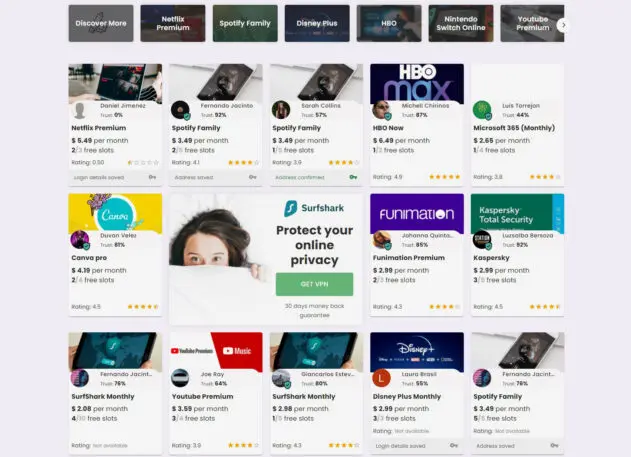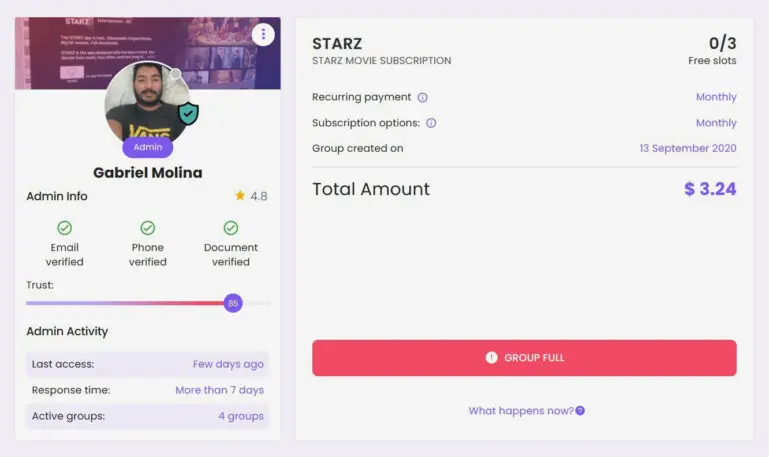Editor’s note: After this story was published, Fast Company learned that the writer had used the service in a way that violated Together Price’s terms and conditions. The story has been reedited to reflect that.
Earlier this week, I bought a month of Starz for a fraction of its typical asking price.
Instead of paying $9 per month, I paid $3.24. Then I added a subscription to Spotify for $3.49, and a Disney Plus subscription for just $3. All told, my bill comes to about $10 per month for $28 worth of services.
Those cut-rate subscriptions come courtesy of Together Price, a service that lets people rent out access to a share of their digital subscriptions. In exchange for a cut of each transaction, Together Price essentially serves as an interface to share subscriptions. The service, which started five years ago in Europe and has 80,000 paying customers, just launched in the U.S. last week.
Together Price asks users to only share subscriptions with members of the same household if the service requires it—as Netflix and Spotify do. But in these cases, it has no mechanisms in place to prevent sharing with others outside the home, and the site provides a menu where users can browse subscriptions from anyone. After this story was published, Together Price banned my account because I’d admitted to joining a stranger’s Spotify group, which is against the service’s terms and conditions.
CEO Marco Taddei says that the service is legal and that it honors each subscription’s terms of use. He also believes the service is helping companies retain users that they’d otherwise lose.
“We are targeting the very specific audience that needs to share,” he says. “If [subscription providers] are not going to allow them do so so, they are going to drop the subscriptions.”

How it works
After signing up for Together Price, you can browse a “network” of users offering to share their subscriptions. Most major streaming video and music services are available, including Netflix, Spotify, Disney Plus, HBO Max, and Hulu, but sharing isn’t limited to media. Some users are also peddling subscriptions to software tools such as Canva Pro and Surfshark VPN, and the site lets you set up custom subscriptions for pretty much anything by listing the service name, price, and sharing rules.
For each service, you send a request to the subscription owner and submit credit card information to Together Price. During this process, you have to attest how you know the account holder—whether you are friends, family, members of the same household, or coworkers. Taddei says that the sharing group admins confirm that only certain users are allowed to share subscriptions with them when they sign up for Together Price. Still, there is no enforcement mechanism to stop users from connecting with strangers. Once the owner accepts the request, Together Price processes the payment, and you’re allowed into a group where you can access login details and chat with the other members.
For me, the process was somewhat unnerving because I was using the accounts of total strangers. I quickly realized that I could see everything my fellow Starz members were watching (my host has The Devil Wears Prada and Little Women on his playlist), and that nothing would stop me from changing the account’s email address and password, which would have locked the other members out.
That’s not the only element of the service that requires trust. To share an Apple Music subscription, for instance, you have to invite the person into your Family Sharing group, which in turn entitles them to use all of your Apple subscriptions. They can also use your payment methods for App Store purchases if you’ve chosen to share those with other family members.
Together Price’s answer to these concerns is a “Trust Level,” which publicly scores users based on their activity on the service. You get points for certain activities, such as verifying your phone number, posting a profile picture, and linking your contacts. You lose them for bad behavior, such as being delinquent on payments or getting negative ratings from group members.
On some level, the service is also just assuming most users aren’t out to screw each other over. Taddei says that while the service had a small number of issues before implementing trust scores, no one has tried to run away with users’ accounts in more than three years.
“What we’re trying to do is create a trustworthy community,” he says.

The challenges of password-sharing apps
Other services have tried to facilitate subscription sharing before, but with little success. DoNotPay offered a Chrome extension to log users into shared accounts without exchanging their actual passwords, but Google promptly pulled it from the Chrome Web Store over copyright claims. A service called Slash briefly let groups split the cost of subscriptions through virtual credit cards, but then pivoted to offering payment tools for scalper bots. Another service called Jam supports both password- and extension-based sharing.
Together Price is unique in the way it facilitates subscription sharing, and Taddei says the service is legitimate. He points to the company’s fundraising on CrowdCube, a site that lets individuals invest in startups and performs its own due diligence on them first. In addition, the company has raised $2 million to date from European investors including Samaipata and LVenture Group.
Taddei also points out that many services don’t have any clear restrictions on password sharing, and only limit users based on how many devices can stream at the same time. In those cases, Together Price lets each group match only the number of simultaneous streams a service offers.
“There’s a lot of misunderstanding when it comes to sharable platforms,” he says. “People think it’s illegal to share, but it’s not.”
Even so, Together Price makes only facile attempts to uphold the terms of use for services with stricter rules. While the site includes succinct summaries of each service’s sharing rules, and makes users agree to those conditions before they sign up, it never tries to verify that users of a shared account live together, as both Netflix and Spotify require.
Taddei says the company could someday try to verify users’ addresses in those kinds of cases. But as it stands, the system can clearly be used to connect people who’ve never met.

How will subscription services respond?
So far, the response from subscription services has been muted. Netflix and Disney declined to comment on Together Price, while a representative for Starz did not respond to a request for comment. Spotify says it sent a cease-and-desist letter to Together Price last month, but it’s unclear what further action the company might take.
Alan Wolk, cofounder and lead analyst of TVRev, believes most streaming services won’t be too concerned about Together Price. Despite years of industry bluster about imminent crackdowns on password sharing, there’s been little evidence of streaming services wanting to inconvenience their paying customers with strict countermeasures.
Wolk notes that streaming services already have password sharing built into their business models. They put limits on simultaneous streams and user profiles, and in some cases they charge more for customers who want to use more devices at the same time. Spotify Family, for instance, costs $16 per month, versus $10 per month for individuals.
“A lot of them feel like, ‘We’d rather just charge a few dollars more if they want to share with their family, because at some point, we’d rather keep them subscribing than not subscribing.”
Taddei says that’s the point. He claims that Together Price’s average churn rate for the first month—that is, the percentage of people unsubscribing from a service—is 0.5%. A recent report by Variety found that major streaming services’ monthly churn rates range from 2% (for Netflix) to 17% (for Apple TV Plus).
“We are helping all those service providers keep their customers,” he says.
They’re just paying a lot less than they otherwise would.
Recognize your brand’s excellence by applying to this year’s Brands That Matter Awards before the early-rate deadline, May 3.
